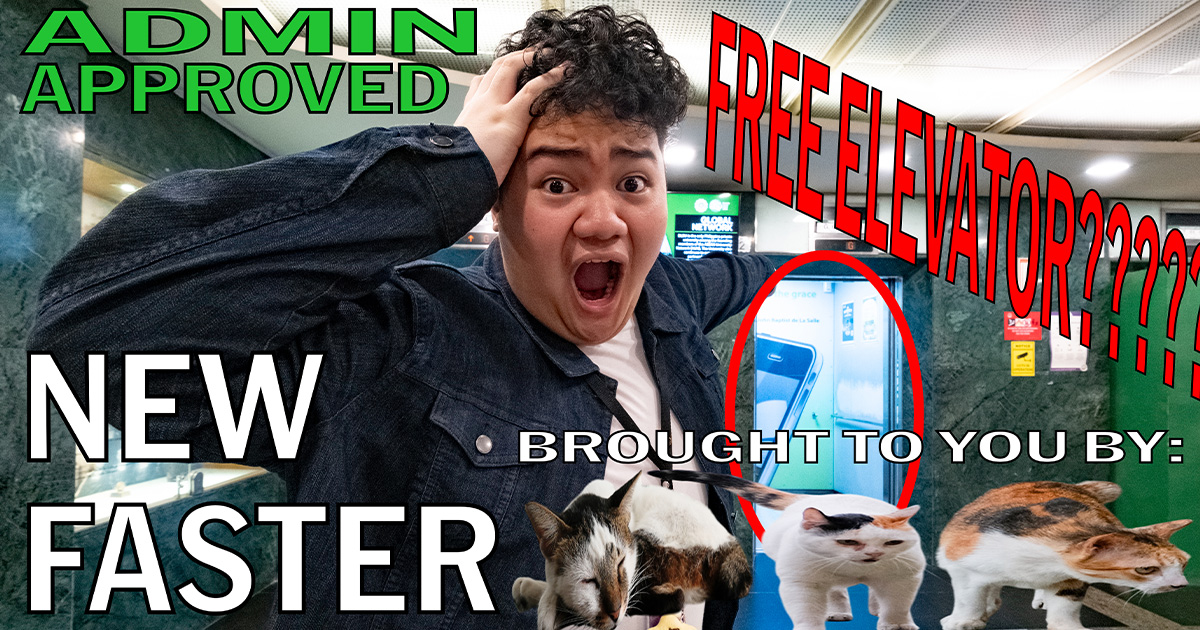In a groundbreaking announcement that left the entire campus abuzz, Lasallian engineers have introduced their newest solution to the long-standing issue of elevator lines at the Br. Andrew Gonzalez Hall.
Rather than addressing the fundamental problem of lengthy queues and limited elevators, the engineering team has opted for a more “magical” approach. Drawing inspiration from Disney theme parks, a queuing system will be implemented to transform the dreadful wait into an enchanting experience.
This initiative finally arrives after years of students arriving to lectures late, sweaty, and seething over the extensive lines stretching to the steps outside the building. Will this banish the notorious elevator woes of Lasallians, or is it merely a sprinkle of fairy dust on a logistical nightmare?
It’s a long wait after all
The newly introduced lining system, dubbed the “Lighting Lift List,” will transform the once chaotic lobby into a meticulously structured and efficient queuing experience. At the heart of this innovation lies the “FastPass system,” allowing scholars, Dean’s Listers, and faculty members to bypass the general queue with a tap of their exclusive RFID stickers.
“It’s all about optimizing vertical mobility,” explains Ellie Baitor, the newly appointed Director of Vertical Transport Management. “Every minute a faculty member or scholar spends waiting for an elevator is a minute they could be securing grants, publishing research papers, or contributing to the University’s global ranking.”
For the rest of the student population, access to elevators has been integrated into LibCal—the same platform used to book study rooms. Students can now reserve their virtual line slot up to three days in advance, with precise 15-minute time windows to ensure a smoother flow of traffic.
“I’m thrilled about this new system,” exclaims Linya Waitmore (II, PHY-MAT) while scrolling through her phone. “I’ve booked my elevator ride for Friday at 2:15 pm, which is perfect since my class starts at 1 pm.” When asked to elaborate on the time difference, she shrugs and adds with a grin, “Time is just a construct, right? So are these elevator lines.”
Baitor further elaborates on the rationale of using LibCal: “Students already use it to book study rooms they rarely show up for.” By applying the same logic to elevators, their goal is to simply cultivate a sense of responsibility—or at least create the illusion that they have control over their time. “It’s all about crafting a blend of hope, delusion, and mild inconvenience,” she adds.

To infinity and beyond
For students unwilling to endure hours for an elevator ride, the University is introducing a new initiative: the Stairs Incentive Program (SIP). Participants who brave the grueling, knee-breaking climb up the 20-story building will be rewarded with a single Stick-O at the top.
“We really want to gamify the struggle,” explains Baitor, who is seemingly oblivious to what the students actually need. “After all, nothing is as satisfying as a wafer after an impromptu cardio session.”
To make the climb feel more worthwhile, the University will roll out limited-edition Stick-O flavors. Tears of Frosh carries the first-years’ taste of regret, while Quatro serves as a sweet treat that students can only dream of as they pause halfway up the building to ponder their life choices.
Baitor adds that students who commit to SIP for an entire term will also receive a certificate recognizing their “commitment to alternative transportation,” an achievement that is equally useful as a DLSU ID on an LRT beep card system.
The happiest wait on Earth
Despite the flashy innovations, the elevators remain as unreliable as ever. Students can still count on the full Br. Andrew Gonzalez Hall experience: agonizingly slow ascents, spontaneous breakdowns, and the existential dread of being trapped between floors just as their professor is taking attendance.
Mark Maghintay (BSMEEMTE, ‘98), an engineer behind the queuing system, has assured students that no further efforts will be made to improve the actual elevators’ performance. Describing it as a “long-term investment,” he believes that these conditions will “help students build resilience, patience, and other valuable life skills.”
To keep students entertained, Baitor will add live mascots—none other than the campus cats—to patrol the queue and offer emotional support. Patty will be stationed in the FastPass lane, glaring at anyone who dares to cut the line. Dweety will manage the regular line, although she will likely fall asleep on duty. Meanwhile, Casper will stay at the entrance of the stairs, reminding students that they can always just climb.
“We considered fixing the elevators, but then we thought, ‘Why not enhance the waiting experience instead?’” Baitor admits with a shrug. “It’s about the journey, not the destination.”
Plans for “future enhancements” are already in the works. Until then, students are encouraged to embrace the new system and enjoy the ride—or more realistically, the wait. After all, at Br. Andrew Gonzalez Hall, real education isn’t in the classrooms but in the line.
This article was published in The LaSallian‘s Spoof 2025 issue. To read more, visit bit.ly/TLSSpoof2025.



